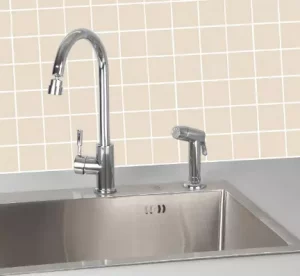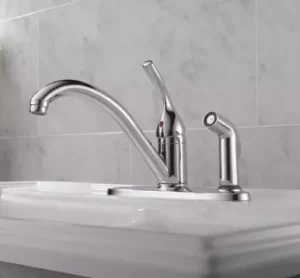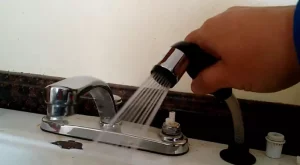A kitchen faucet with sprayers makes cleaning veggies or washing dishes simpler. However, they may be more prone to wear and tear than standard faucets. Their moving parts tend to wear out faster.
So, you may not be able to take advantage of their amazing services for very long before experiencing a problem. And, it can cause some frustration when the sprayer stops working.
What is Kitchen Sink Sprayer?
A kitchen sink sprayer is a handy kitchen sink accessory that attaches to the side of your kitchen faucet. It is an adaptable gadget and works well in the kitchen.
It can allow you to clean hard-to-reach areas that your regular kitchen faucet can’t. The sprayer can be mounted on the side of the sink deck or integrated into the spout.
How to Fix a Kitchen Sink Sprayer that won’t Spray
To fix a single-handle faucet:

- Close the lines by turning both water supply valves beneath the sink clockwise. Drain any standing water from the lines by turning on the water at the faucet.
- Use a hex key or screwdriver to loosen the setscrew on the faucet handle. Remove the faucet’s handle.
- To protect the finish on the faucet spout, wrap the cap in an old rag and place it behind the spout. Turn the cap counterclockwise with tongue-and-groove pliers. Detach it by turning it counterclockwise with your fingers.
- Using your hands, grab the spout of a single-handle faucet. Remove the spout from the faucet’s body to reveal the diverter.
- Look inside the round opening along the rear or front of the faucet body for the original diverter. With needle-nose pliers, grab the little diverter and remove it from the faucet’s front.
- Take the diverter to a hardware store or a plumbing supply store. Find a diverter that is identical to the original.
- Replace the diverter by inserting it into the diverter aperture. To check that the diverter is correctly seated, push it with your finger.
- Replace the spout on the faucet. Twist the cap clockwise with your hand to tighten it. Replace the handle on the faucet. Remove the set screw and tighten it. To open the lines, turn both supply valves counterclockwise.
Read on how to replace a leaking pipe under the kitchen sink.
To fix a double-handle faucet:
- Close both water supply valves under the sink by turning them clockwise. Drain any standing water from the lines by turning on the water at the faucet.
- To protect the finish on the faucet spout, wrap the cap in an old rag and place it under the spout. Turn the cap counterclockwise with tongue-and-groove pliers. Completely remove the cap by rotating it counterclockwise using your fingers, exposing the diverter.
- Inspect the faucet body for the diverter. In the top slots of the diverter, place a nickel. Turn the diverter in the opposite direction. Using the pliers, lift it away from the faucet’s body.
- Take the diverter to a hardware store or a plumbing supply store. Find a diverter that is identical to the original.
- Thread-seal tape the threads at the bottom of the diverter. Install the diverter in the faucet’s body. Turn the diverter clockwise with a coin.
- Install the cap by hand, turning it clockwise. To open the lines, turn both supply valves counterclockwise.
How to Fix a Stuck Kitchen Sink Sprayer that Won’t Spray
To fix a two-handle faucet diverter:

- Turn the cold and hot water supply valves under the sink clockwise to close them. Then turn on the faucet to ensure that the water supply is off.
- Place a rag atop the cap behind the two-handled faucet. Using tongue and groove pliers, make sure the cap spins counterclockwise.
- Take off the cap to reveal the diverter. Insert the butter knife inside the diverter’s lid. Then, rotate the diverter in the opposite direction. It will detach the diverter from the body of the faucet.
- After that, move the faucet cap over the faucet body. Cover the faucet cap with a towel and tighten it with pliers. To feed water to the faucets, turn the supply valve knobs anticlockwise.
To fix a single-handled faucet:
- Stop the hot and cold-water supply by turning the supply valve underneath the sink clockwise.
- Look for a little set screw near the bottom of the single-handled faucet’s handle. To loosen them, use a Phillips screwdriver. Remove the faucet handle to gain access to the cap.
- Place a rag above the faucet cap and behind the single-handled faucet’s spout
- Rotate the spout of the faucet body softly back and forth while exerting upward pressure. As a result, the faucet diverter lies in front of the faucet body.
- Insert a flat-head screwdriver into the faucet body and turn the diverter rearward
- Place the clean diverter within the faucet body’s aperture
- Return the cap into the faucet
At times, the hot water may not be working in the kitchen, will you fix the sink or faucet?
Causes of Kitchen Sink Sprayer Not Turning Off
The sprayer may not shut off because the lever is dysfunctional. It may mean you need to replace the handle, its seat, or the stem washer. If the handle is functioning well, there is usually a problem with the diverter. It is the valve that sends water from the spout to the sprayer. Usually, the valve lies near the base of the spout. Changing it may be your best option because it is cheap.
How to Fix a Kitchen Sink Sprayer that Won’t Shut Off
To fix the kitchen sink sprayer you will need:

- Needle-nose pliers
- Adjustable pliers
- Penetrating oil
- Dinner knife
- Coin
- Rag
- To stop a sprayer that won’t stop spraying, use one hand to hold the sprayer. On the other hand, work a dinner knife under the lever and push down on the valve button. When the water is running, the water pressure helps close the valve.
- Once the sprayer is closed, turn off the faucet and lubricate the valve button with penetrating oil to make it glide more easily.
- If you can’t push the valve in or it won’t stay in, turn off the hot and cold-water valves and remove the sprayer from the hose with adjustable pliers. Purchase a replacement sprayer from your local hardware store. It is easier and less expensive than disassembling and attempting to repair the sprayer.
- Change the diverter if water flows to the sprayer every time you turn the faucet on. The diverter lies beneath a cap at the base of the faucet in two-handled faucets. Turn off the shutoff valves and use adjustable pliers to unscrew the cap. To protect the finish on the cap, wrap a towel around it before gripping it with the pliers.
- Use a penny to unscrew the diverter, then needle-nose pliers to pull it out. Replace it with a new one from the hardware shop, then drop it in and tighten it with the coin. Return the cap to its original position.
How to Maintain Your Kitchen Sink Sprayer
The equipment requires regular maintenance because of the makeup of tap water. Elements of the sink sprayer exposed to the liquid are prone to clogging from debris and mineral deposits. You clean the sink sprayer thoroughly to resolve poor functionality difficulties caused by the debris.
If regular cleaning with mild soap and water isn’t working, disassemble the sprayer. Clean the necessary parts with white vinegar or scrub the residues with a cloth or toothbrush.
Using 50/50 mixture of white vinegar and warm water:
- Clean and wipe the hose
- Clean the nozzle using a cloth/toothbrush to scrub the nozzle holes
- Dry the hose
Before using the sprayer to rinse food or fill a water glass, run super-hot water through the flow holes for a few minutes. It helps to clear any leftover debris or vinegar solution.

As a homeowner, I am specifically keen on home improvement. I am passionate about homes, yards, and home improvement. I blog on home ideas and reviews on solutions that make homes better.
